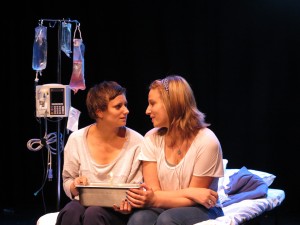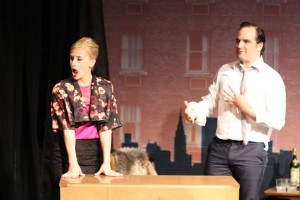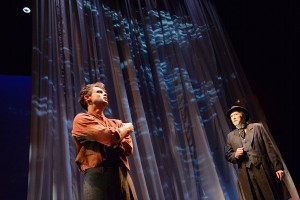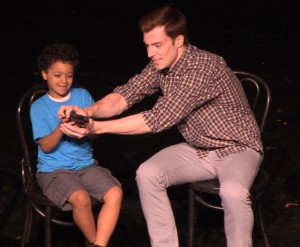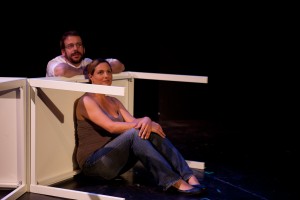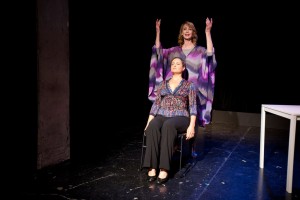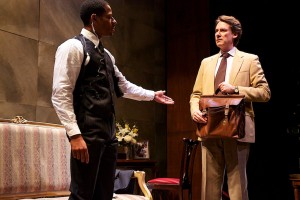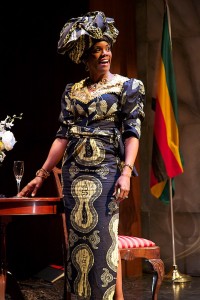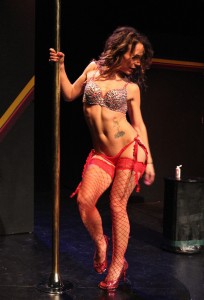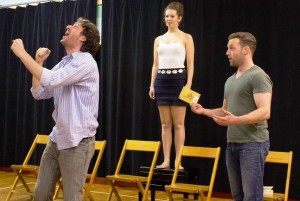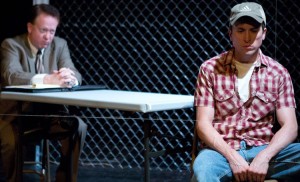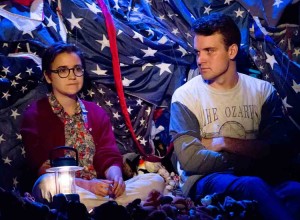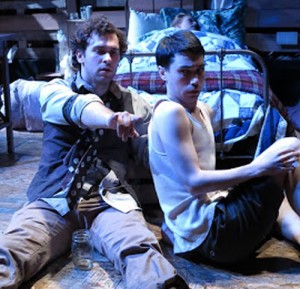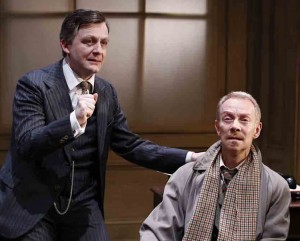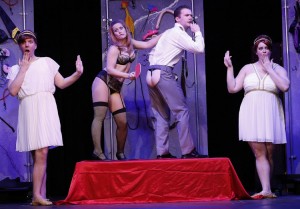From the moment the lights dimmed and music started, I knew that 23 Year Old Myth was not going to be your average jukebox musical. With a genre-bending soundtrack (ranging from the indie hits of Florence and the Machine and MGMT, to original material by members of the company such as Emma Barash and playwright Leslie Gauthier), the play – which is part of Theater for the New City’s Dream Up Festival — is a musical about one girl’s journey of love and loss in the city, all told through the plucking strings of the ukulele.
Loosely based on Gauthier’s own personal experiences, the play finds Girl 1 (played by Gauthier herself) falling in love with Girl 2 (Lindsay Cook), just as she is diagnosed with cancer. Narrated by a lone figure dressed as a subway busker, known as Ukulele Man (Brendan McDonough), 23 Year Old Myth is presented in a series of scenes that act as “snippets” of the journey. The transitions from scene to scene are clever, with the company not only doubling as stagehands but also as props — and even part of the set themselves — with some pushing and pulling the bed into place while one poses as a standing lampshade. Daniel Geggatt and Michael Steiner’s set is meant to reflect this youthful, metropolitan feel of the play: a single bed facing the audience lengthwise; and later on, a couple of chairs, hospital curtains, a metal food tray, as well the aforementioned handheld lampshades; and two blue subway pillars stand at opposite ends of the stage, with a single yellow line demarcating where the platform ends and where the tracks begin, a sign of the journey to come.
In the first few of these scenes, Gauthier memorably captures life as a twenty-something living in New York City: young, vital and alive. The show opens with the cast all dressed by Jenny Kessler in variations of blue jeans and white shirts, standing in various positions onstage and yelling out typical “New York-isms” in alternating spurts (“I lost my MetroCard!” “Wallet in Cab!”), as Girl 1 makes her way across the stage. She stands on a subway platform, singing along to Florence and the Machine’s “Between Two Lungs” at the top of her lungs – in all appearances, just a regular 22-year-old starting her life. In the middle of her private concert, Girl 1’s train arrives, and she runs for it, only to trip just as the doors close. Her journey has started, if with a little fumble.
It is here we first take notice of Ukulele Man, who softly provides musical accompaniment throughout the play. He is not quite Stew of Passing Strange, though not quite Tom Wingfield in The Glass Menagerie, either. McDonough’s character seems more in the vein of Evita’s Che, a sort of hipster bearing witness to the struggles of Girl 1 with her illness and how it affects her relationships. Midway through he disappears, perhaps signifying how people in your life will come and go, depending on your need for them. He helps tell Girl 1's story with as much wit and pathos as needed, as do the rest of the vibrant cast.
In fact, it is the company’s energy that truly makes this show, providing each scene with the right balance of both humor and humility, especially during the middle portion of the show, the bulk of which takes place during Girl 1’s time at the hospital. Together, they breathe life into Gauthier’s wonderfully natural dialogue and make certain moments seem as if we’re witnessing our own friends interact.
In one scene, Girl 1 visits an old friend (the delightful Barash), who stumbles through the painfully realistic discomfort of greeting someone whom you know is dying. Girl 2 struggles with how to take every reaction to her situation. How does one go back to being young again when every question or proposal comes underscored with the possibility that you may die? This scene (and every scene before and after, for that matter) in the latter half of the show treads this line with beautiful execution, veering back and forth from laughter to tears, and back to laughter once again.
According to the show’s program, the show is based on “the parallels between falling in love and being diagnosed with a disease,” an idea which is represented through Girl 1 and Girl 2’s relationship. Cook’s Girl 2 is like any lover confronted with a disease; her portrayal is one of selfless strength and love at the beginning, yet filled with regretful inadequacy towards the end. Just as with the disease, their relationship goes through stages of positivity, denial, anger and finally acceptance. That is, after all, the journey of life.
23 Year-Old Myth is a story of mythical proportions, taking you on a journey where the littlest things can have the biggest impact. This unusual musical play takes you by surprise, bringing moments filled with laughter and tears, plucking at your heartstrings.






